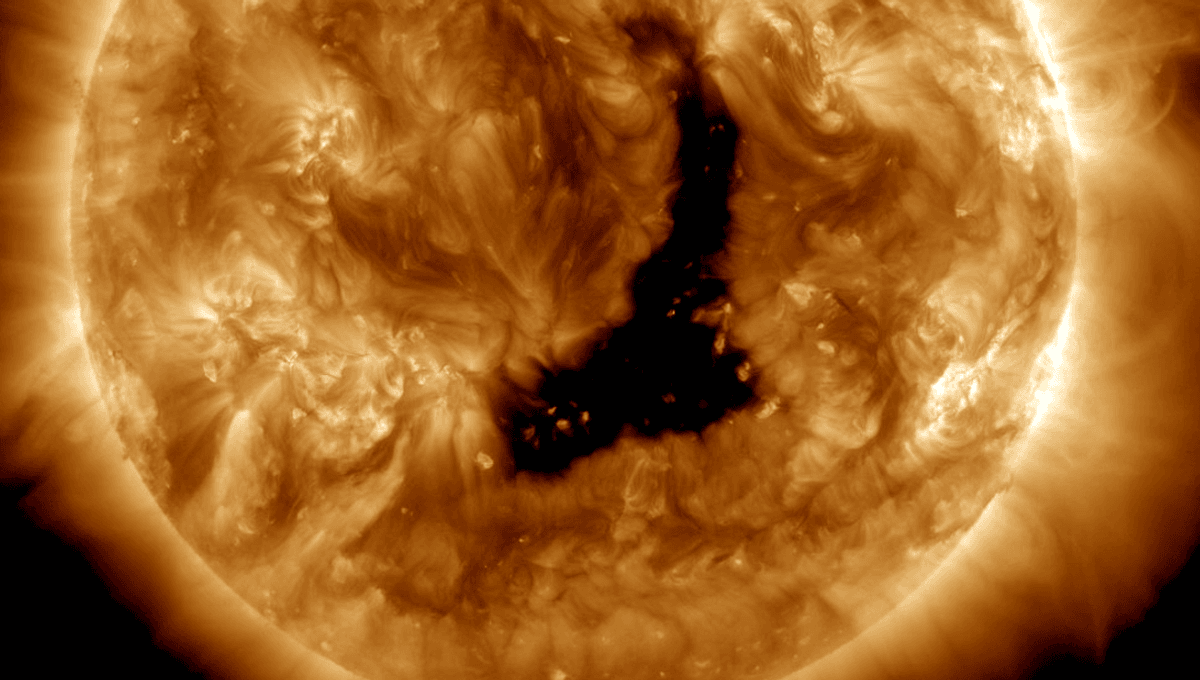
As the Sun approaches the solar maximum – the height of its activity during its 11-year cycle – two studies have come out suggesting that we do not currently have the systems in place to study solar storms properly, or ones that large
Solar storms are a pretty common occurrence – a moderate storm was predicted to take place yesterday and today, for example, after a large hole opened up on the Sun’s surface. There’s nothing the Sun loves more than being hot and flinging plasma in our direction.
The storms are generally nothing to worry about, unless you are particularly averse to looking at the beauty of the northern lights, or minor problems with power grids, and radio communication. Now and then, however, there is a big one.
The most famous, known as the Carrington Event took place on September 1-2, 1859. In the previous month, astronomers had noticed a large number of sunspots as the Sun approached the solar maximum. Richard Carrington, an amateur astronomer, was observing and sketching the spots when he saw a “white light flare” erupting from the solar photosphere.
After 17.6 hours – much faster than it usually takes coronal mass ejections to reach Earth – it hit our planet. It caused some of the brightest auroras in recorded history, visible even near the equator, and allowed people in New England to read in the middle of the night unaided by other light sources.
There were downsides to the event, including that the world’s 160,000 kilometers (100,000 miles) of telegraph lines at the time were rendered temporarily useless.
Searching for the event by looking for telltale increases in carbon-14, other scientists have found even larger geomagnetic storms that dwarf even the Carrington Event. This includes one that took place between 774 and 775 CE, and appears to have been a global event.
Were storms of this scale to take place again today, with our reliance on GPS and with a much more complicated power grid, consequences would be much more wide-ranging and severe. A NASA study found that more than 130 million people would be left without power if a Carrington Event-sized storm hit today, with several knock-on effects.
“Water distribution [will be] affected within several hours; perishable foods and medications lost in 12-24 hours; loss of heating/air conditioning, sewage disposal, phone service, fuel re-supply and so on.”
“The concept of interdependency,” the report adds, “is evident in the unavailability of water due to long-term outage of electric power–and the inability to restart an electric generator without water on site.”
GPS could also be knocked offline if the storm was powerful enough to knock out our communications satellites. Now the bad news; these storms may be more common than we realized.
A study published this month looked at the Chapman-Silverman storm of February 1872. Looking at geomagnetic field measurements taken at the time, as well as historical records of sunspots and hundreds of aurora reports from the storm, the team determined that the storm was stronger than we realized.
“Our findings confirm the Chapman-Silverman storm in February 1872 as one of the most extreme geomagnetic storms in recent history. Its size rivalled those of the Carrington storm in September 1859 and the NY Railroad storm in May 1921,” lead author Hisashi Hayakawa said in a statement. “This means that we now know that the world has seen at least three geomagnetic superstorms in the last two centuries. Space weather events that could cause such a major impact represent a risk that cannot be discounted.”
“On the one hand, we are fortunate to have missed such superstorms in the modern time,” Hayakawa added. “On the other hand, the occurrence of three such superstorms in 6 decades shows that the threat to modern society is real.”
Another recent study looked at data collected during a strong solar storm in December 1977. The data was collected by 32 stations of the Scandinavian Magnetometer Array (SMA), meaning the team could get a more localized view of the effects of solar storms.
“Usually today, we look at the whole of the Earth’s auroral region as a single entity,” Otto Kärhä, a doctoral researcher involved in the study, explained in a statement. “However, we used more than 30 instruments to map the effects of a single solar storm from the Arctic Ocean to the Bothnian Sea.”
The team found large local variations in the effects of the storm, suggesting what we really need is more detectors.
“When such a solar storm hits, too sparse magnetometer network could lead to underestimation of local magnetic disturbances and underestimation of the preparedness for them,” Professor Eija Tanskanen, director of the Sodankylä Geophysical Observatory, explained.
“A denser magnetometer network would help to understand the complex structure of the magnetic field during solar storms. We could provide local warning of solar storm movements, and better safeguard infrastructure vulnerable to magnetic disturbances. Air traffic, for example, could also be warned more regionally about strong magnetic clouds and storms.”
In summary, large solar storms could do significant damage to society, occur more often than we thought, and we don’t have adequate detection in place for further study.
The study which looked at the strength of the Chapman-Silverman event is published in The Astrophysical Journal. The study looking at the solar storm of 1977 is published in Nature Scientific Reports.
Source Link: Carrington Event-Sized Solar Storms Are More Common Than We Thought